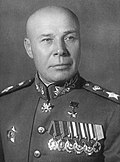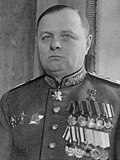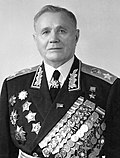Top Qs
Timeline
Chat
Perspective
Marshal of the Soviet Union
Highest Soviet military rank From Wikipedia, the free encyclopedia
Remove ads
Marshal of the Soviet Union (Russian: Маршал Советского Союза, romanized: Marshal sovetskogo soyuza, pronounced [ˈmarʂəl sɐˈvʲetskəvə sɐˈjuzə]) was the second-highest military rank of the Soviet Union. Joseph Stalin wore the uniform and insignia of Marshal after World War II.
Remove ads
Rank insignias of Marshal of the Soviet Union
The rank of Marshal of the Soviet Union was created in 1935 and abolished in 1991 when the Soviet Union dissolved. Forty-one people held this rank. The equivalent naval rank was until 1955 admiral of the fleet and from 1955 Admiral of the Fleet of the Soviet Union.
Remove ads
History of the rank
Summarize
Perspective

The military rank of Marshal of the Soviet Union was established by a decree of the Soviet Cabinet, the Council of People's Commissars (Sovnarkom), on 22 September 1935. On 20 November, the rank was conferred on five people: People's Commissar of Defence and veteran Bolshevik Kliment Voroshilov, chief of the General Staff of the Red Army Alexander Yegorov, and three senior commanders, Vasily Blyukher, Semyon Budyonny, and Mikhail Tukhachevsky.
Of these, Blyukher, Tukhachevsky, and Yegorov were executed during Stalin's Great Purge of 1937–38. On 7 May 1940, three new marshals were appointed: the new People's Commissar of Defence, Semyon Timoshenko, Boris Shaposhnikov, and Grigory Kulik.
During World War II, Kulik was demoted for incompetence, and the rank of Marshal of the Soviet Union was given to a number of military commanders who earned it on merit. These included Georgy Zhukov, Ivan Konev and Konstantin Rokossovsky to name a few. In 1943, Stalin himself was made a Marshal of the Soviet Union, and in 1945, he was joined by his intelligence and police chief Lavrentiy Beria. These non-military marshals were joined in 1947 by politician Nikolai Bulganin.
Two Marshals were executed in postwar purges: Kulik in 1950 and Beria in 1953, following Stalin's death. Thereafter the rank was awarded only to professional soldiers, with the exception of Leonid Brezhnev, who made himself a marshal in 1976, and Dmitry Ustinov, who was prominent in the arms industry and was appointed Minister of Defence in July 1976. The last Marshal of the Soviet Union was Dmitry Yazov, appointed in 1990, who was imprisoned after the failed coup against Mikhail Gorbachev in 1991. Marshal Sergei Akhromeyev committed suicide in 1991 during the fall of the Soviet Union.
The Marshals fell into three generational groups.
- Those who had gained their reputations during the Russian Civil War. These included both those who were purged in 1937–38 (Blyukher, Tukhachevsky, and Yegorov), and those who held high commands in the early years of World War II (Budyonny, Kulik, Shaposhnikov, Timoshenko and Voroshilov). All of the latter except Shaposhnikov and Timoshenko proved out-of-step with modern warfare and were removed from commanding positions.
- Those who built their reputations during World War II and assumed high commands in the latter part of the war. These included Zhukov, Vasilevsky, Konev, Rokossovsky, Malinovsky, Tolbukhin, Govorov, and Meretskov.
- Those who assumed high command during the Cold War era. All were officers in World War II, but their higher commands were held in the Warsaw Pact or as Soviet defence ministers. These included Sokolovsky, Grechko, Yakubovsky, Kulikov, Ogarkov, Akhromeyev, and Yazov.
All marshals in the third category had been officers in World War II, except Ustinov, who had been People's Commissar for Armaments. Even Yazov, who was 20 when the war ended, had been a platoon commander. Brezhnev was not a professional soldier, but was still commissioned as a political commissar in the war.
Of the 35 Marshals who were career soldiers, the majority were of Russian origin. Timoshenko (Tymoshenko), Kulik (Kulyk), Grechko (Hrechko), Yeremenko (Yeryomenko), Moskalenko, Batitsky (Batytsʹkyy) and Koshevoy (Koshovyy) were of Ukrainian origin, while Sokolovsky (Sakaloŭski) and Yakubovsky (Jakuboŭski) had Belarusian origins. Rokossovsky (Rokossowski) was born in Congress Poland to a Polish family, while Malinovsky (Malinowsky) was born in Odessa (now in Ukraine) to a Polish father. Tukhachevsky also had Polish ancestry. Bagramyan (Baghramyan) was the sole marshal of Armenian origin.
The rank was abolished with the dissolution of the Soviet Union in December 1991. It was succeeded in modern Russia by the rank of Marshal of the Russian Federation, which has been held by only one person, Igor Sergeyev, who was Russia's defence minister from 1997 to 2001. There have been no living marshals since Yazov's death in February 2020.
Remove ads
List of marshals
Remove ads
Timeline

See also
- Marshal of the Russian Federation
- History of Russian military ranks
- Military ranks of the Soviet Union
- Marshal of the branch
- Chief marshal of the branch
- Admiral of the Fleet of the Soviet Union
- Field marshal (Russian Empire)
- Marshal of the People's Republic of China
- Marshal (North Korea and South Korea)
Notes
- Positions held during active service as a marshal, within the Red Army/Soviet Armed Forces, Communist Party, or non-CPSU governmental apparatus. Selected minor positions are hidden.
- Years spent in active service as a marshal. Soviet marshals, with a few exceptions, typically held prominent positions—including full or candidate membership of the CPSU's Central Committee and Politburo/Presidium—without explicitly retiring. Interregna between the holding of such positions are not counted. Retirement for the purposes of counting years on this list are:
- Appointment as a member of the Group of Inspectors General, a sinecure for superannuated senior officers (e.g. Timoshenko, Vasilevsky, Konev).
- Demotion in rank (e.g. Kulik).
- Resignation or dismissal from office or as a member of ruling Communist Party or state organs (e.g. Voroshilov, Zhukov, Sokolov).
- Death in office (e.g. Stalin, Brezhnev, Ustinov).
- Arrest and/or execution, with summary dismissal from all offices (e.g. Blyukher, Tukhachevsky, Beria).
- Includes lifespan; awards of the Hero of the Soviet Union, Hero of Socialist Labour, and Order of Victory; major appointments before promotion to and after retirement as a marshal; and unusual career events such as demotion, removal from office, and purges by Communist Party leadership.
- as Deputy Chairman, Council of People's Commissars (1940–1946)[3]
- Candidate member of the 17th Central Committee until promotion at the 12th Plenary Session (12 October 1937)[20]
- Stripped of rank and honours, 16 February 1942; dismissed as deputy people's commissar for defence and expelled from Central Committee, 19 February 1942; appointed as major general, 17 March 1942; promoted to lieutenant general, 15 April 1943; demoted to major general, 9 July 1945; arrested and stripped of rank, 11 January 1947; executed, 24 August 1950; rehabilitated and posthumously restored as marshal, 28 September 1957.[26]
- as First Deputy Minister of War (5–15 March 1953)[6]
- Dismissed as minister of defence, 26 October 1957; terminated from active military service, 27 February 1958.[32]
- as Minister of the Armed Forces (1949–1950)[39]
- as Supreme Commander in Chief, Red Army (1941–1946)
- as Chairman, Council of People's Commissars (1941–1946)[3]
- as People's Commissar for Defence (1941–1946); People's Commissar for the Armed Forces (February–March 1946)[42]
- Appointed to Group of Inspectors General, July 1960; recalled as marshal to command Group of Soviet Forces in Germany, 13 August 1961; reappointed to Group of Inspectors General, April 1962.
- as Deputy Minister of the Armed Forces (until February 1950)[39]
- Candidate member of the 18th Politburo until promotion at the 8th Plenary Session (18 March 1946)[61]
- as First Deputy Minister of the Armed Forces (1949–1950)[39]
- as First Deputy Minister of War (1952–1953)[62]
- as Minister of War (5–15 March 1953)[6]
- Candidate member of the 17th Central Committee until promotion at the 12th Plenary Session (12 October 1937)[20]
- Candidate member of the 18th Politburo until promotion by poll (18 February 1948)[61][67]
- Directly appointed as General of the Army, 29 April 1976; promoted to Marshal of the Soviet Union, 30 July 1976.
- as People's Commissar for Armaments (1941–1946); Minister of Armaments (1946–1953)[39]
- Candidate member of the 23rd Central Committee until promotion at the 7th Plenary Session (9–10 April 1968)[77]
- Candidate member of the 26th Central Committee until promotion at the 6th Plenary Session (14–15 June 1983)[78]
- Candidate member of the 27th Central Committee until promotion at the 4th Plenary Session (26 June 1987)[79]
Remove ads
References
Bibliography
External links
Wikiwand - on
Seamless Wikipedia browsing. On steroids.
Remove ads













































